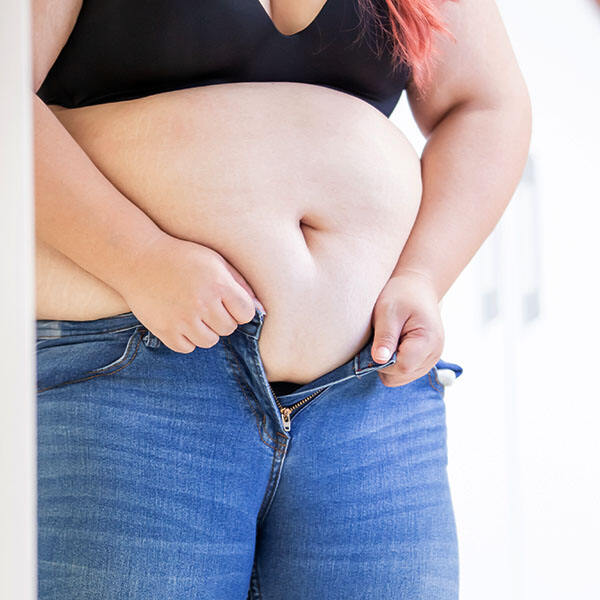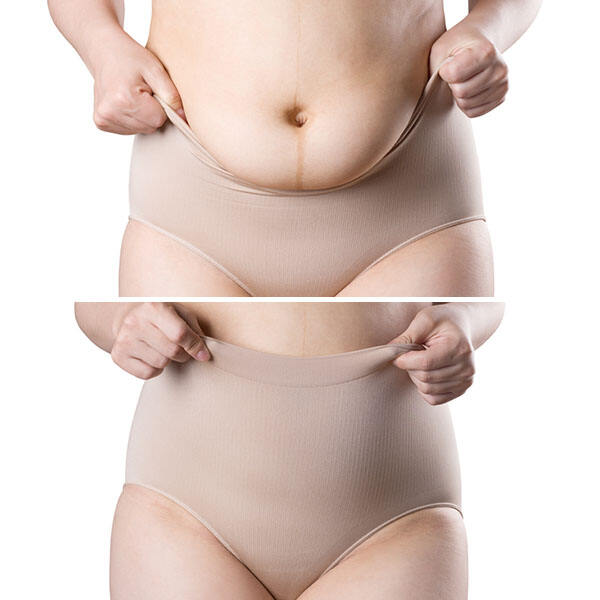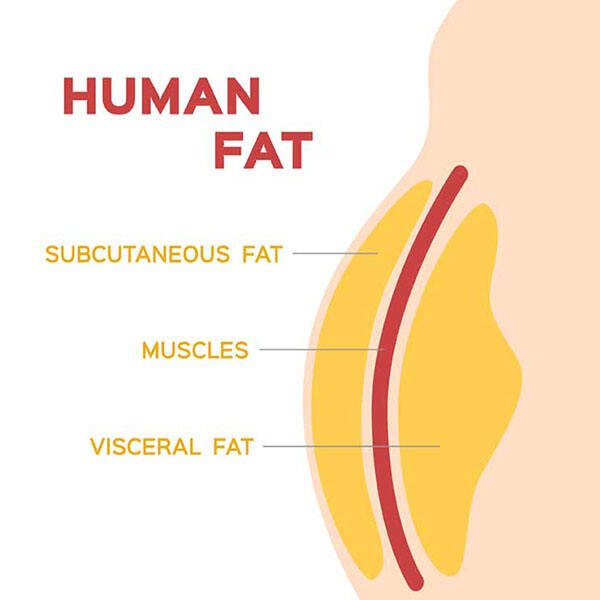हॉर्मोन |
आम ट्रिगर |
वसा भंडारण पैटर्न |
कौन संकट में है |
कोर्टिसोल |
पुराना तनाव, खराब नींद |
पेट, कमर, पीठ |
कोई भी, विशेष रूप से तनाव में व्यक्ति |
एस्ट्रोजन |
रजोनिवृत्ति, बुढ़ापा |
निचला पेट और कूल्हों |
40 के बाद की महिलाएं |
इन्सुलिन |
चीनी/अनाज युक्त आहार |
गहरी पेट की चर्बी |
कोई भी व्यक्ति, विशेष रूप से T2D के साथ |
टेस्टोस्टेरोन |
पुरुषों में बुढ़ापा, निष्क्रियता |
उदर और कूल्हों का क्षेत्र |
35 वर्ष से अधिक आयु के पुरुष |
4. बुढ़ापा और धीमी चयापचय की प्रक्रिया
बुढ़ापे के साथ हार्मोनल परिवर्तन, मांसपेशियों की हानि (सार्कोपीनिया), और चयापचय में धीमी गति से होने वाली कमी आती है। ये सभी परिवर्तन सामूहिक रूप से मध्य भाग के आसपास जमा होने वाली जिद्दी चर्बी को बढ़ावा देते हैं।
· कम मांसपेशियां = कैलोरी जलने की धीमी दर
· रजोनिवृत्ति और एंड्रोपॉज, वसा को पेट की ओर स्थानांतरित कर देते हैं
· लोच में कमी का मतलब है कि त्वचा और नीचले ऊतक कम सहारा देते हैं, जिससे 40 के बाद मफिन टॉप अधिक स्पष्ट हो जाते हैं
5. स्थिर जीवनशैली: गतिहीनता और व्यायाम की कमी
आधुनिक जीवन का अर्थ अक्सर कई घंटों तक कार्यालय की मेज पर, कारों में और सोफे पर बैठना होता है। जब शारीरिक गतिविधि कम हो जाती है, तो कैलोरी जलाने की क्षमता और मांसपेशियों की टोनिंग भी कम हो जाती है।
· कम गतिविधि = अधिक वसा संग्रहित होना
· कोर मजबूती में कमी = मध्य भाग को सहारा देने वाली मांसपेशियां कमजोर होना, मफिन टॉप बढ़ाना
· कार्डियो या स्ट्रेंथ ट्रेनिंग नहीं = मौजूदा पेट की वसा को कम करना मुश्किल
मफिन टॉप को रोकने के लिए सबसे अच्छा व्यायाम:
· तेज़ चलना, पैदल यात्रा, तैराकी, मुक्केबाजी, साइकिल चलाना
· स्ट्रेंथ ट्रेनिंग (कोर, ग्लूट्स, पैर)
· HIIT या इंटरवल ट्रेनिंग
6. ख़राब नींद और पुराना तनाव
विज्ञान निरंतर नींद की कमी और तनाव को उच्च कोर्टिसोल स्तर से जोड़ता है, जिससे पेट के इर्द-गिर्द वसा जमा होती है। नींद न लेना या तनाव में रहना भूख हार्मोन को बाधित करता है, जिससे आपको कैलोरी से भरपूर और चीनी युक्त भोजन की तलब होती है और रात में तलब और बढ़ जाती है।
· 7–9 घंटे की आरामदायक नींद का लक्ष्य रखें
· आराम के लिए समय निर्धारित करें (योग, ध्यान, शौक का समय)
7. शराब, धूम्रपान और कुछ दवाएं
· शराब (विशेषकर बियर और चीनी युक्त कॉकटेल) में "खाली कैलोरी" होती है और पेट में वसा जमा करने में सहायता करती है
· धूम्रपान उपापचय और वसा वितरण को प्रभावित कर सकता है (और सभी स्वास्थ्य जोखिमों में वृद्धि करता है)
· दवाएं (जैसे कॉर्टिकोस्टेरॉइड्स, एंटी-डिप्रेसेंट्स, मधुमेह दवाएं) कूल्हों और कमर के इर्द-गिर्द वसा जमा करने या बढ़ाने का कारण बन सकती हैं
8. गर्भावस्था, प्रसवोत्तर और ढीली त्वचा
गर्भावस्था में पेट की दीवारों और त्वचा को खींचा जाता है। प्रसव के बाद, कई लोगों को कमर के ऊपर एक नरम, लटकती हुई सूजन का अनुभव होता है, जो अतिरिक्त वसा और ढीली त्वचा के कारण होती है।
· वजन घटाने/गर्भावस्था के बाद ढीली त्वचा को पूरी तरह से ठीक होने में समय या मेडिकल/शरीर के आकार को सुधारने वाले उपायों की आवश्यकता हो सकती है
9. कपड़े: "दिखावट बनाम कारण" कारक
हालांकि टाइट कपड़े वास्तव में वसा नहीं बनाते, लेकिन वे वसा को धकेलते हैं और उसे दिखाते हैं। आकार सुधारने वाले वस्त्र, हाई-राइज़ जींस और संपीड़न वस्त्र आपके सिलूएट को चिकना कर सकते हैं लेकिन नीचे जमा वसा को दूर नहीं करते।
केस स्टडी: सारा का 3 साल का मफिन टॉप संघर्ष
36 वर्षीय विपणन कार्यकारी सारा नियमित व्यायाम के बावजूद एक मफिन टॉप के साथ संघर्ष कर रही थी। उसने अपनी नींद और तनाव के स्तर की जांच शुरू की और पाया कि डेडलाइन के लिए रात में पढ़ाई करने से उसे चिप्स और मिठाई खाने के लिए मजबूर कर दिया जाता है। द्वारा:
· 8 घंटे की नींद को प्राथमिकता देना,
· प्रसंस्कृत नाश्ता को उच्च-फाइबर फलों से बदलना,
· हर हफ्ते 3 बार हाई-इंटेंसिटी इंटरवल ट्रेनिंग (HIIT) जोड़कर, सारा ने अपने मध्य भाग की वसा को 2 इंच तक कम कर दिया—बिना किसी प्रतिबंधात्मक "आहार" के।
वसा के प्रकार: उपचर्मीय बनाम विस्सेरल
मफिन टॉप और पेट की चर्बी के बारे में कम जानी गई बात यह है कि यहां वास्तव में विभिन्न प्रकार की चर्बी शामिल होती है। सभी कमर की मोटाई एक जैसी नहीं होती है—कुछ नरम होती है और त्वचा के ठीक नीचे होती है, जबकि कुछ गहरे अंदर छिपी होती है और अधिक स्वास्थ्य जोखिम पैदा करती है।
इस अंतर को समझना आपके दृष्टिकोण को सौंदर्य संबंधी चिंता से स्वास्थ्य संबंधी वास्तविक प्रेरणा में बदल सकता है।
उपचर्मीय चर्बी: 'पिंचेबल' परत
उपचर्मीय चर्बी त्वचा के ठीक नीचे की चर्बी की परत होती है। यदि आप अपनी कमर की पट्टी के ऊपर के क्षेत्र को दबा सकते हैं—विशेष रूप से यदि यह नरम और गतिशील लगती है—तो यह उपचर्मीय चर्बी का ही प्रभाव है। यह दृश्यमान मफिन टॉप, लव हैंडल्स और उन मुलायम जगहों के लिए जिम्मेदार है, जिन्हें अधिकांश लोग पतला करना चाहते हैं।
· नरम लगती है और आसानी से दबाई जा सकती है
· पूरे शरीर में पाई जाती है, लेकिन कमर, कूल्हों और जांघों में अधिक मात्रा में जमा होती है
· सीमित मात्रा में इसका मुख्य स्वास्थ्य जोखिमों से कोई संबंध नहीं होता है
· अतिरिक्त कैलोरी (वजन बढ़ना)
· आनुवांशिकी (कुछ लोगों में इसका भंडारण अधिक होता है)
· हार्मोनल परिवर्तन (एस्ट्रोजन, कोर्टिसोल, इंसुलिन)
· शारीरिक गतिविधि में कमी
त्वरित तथ्य: उपत्वचीय वसा (सबक्यूटेनियस फैट) ऊर्जा संग्रह के रूप में कार्य करती है और जब आपके शरीर को कैलोरी की कमी होती है, तो यही पहला स्रोत होता है।
विसेरल वसा: छिपा स्वास्थ्य संकट
विसेरल वसा पेट की गहराई में पेट की गुहा के अंदर संग्रहीत होती है। इसे बाहर से नहीं दबाया जा सकता – यह आपके अंगों जैसे यकृत, आंतों और अग्न्याशय के चारों ओर घिरी रहती है। यह प्रकार की वसा अधिक चिंताजनक होती है, क्योंकि इसका संबंध पुरानी बीमारियों और चयापचय संबंधी जोखिमों से मजबूती से जुड़ा है।
· कठोर, "टाइट-बेल्ट" संवेदन (पेट मुलायम नहीं, कठोर महसूस हो सकता है)
· बाहर से दिखाई नहीं देता, लेकिन कमर के माप में वृद्धि करता है
· अक्सर एक "सेब के आकार वाले" या "पॉटबेली" रूप से जोड़ा जाता है
· स्वास्थ्य संबंधी खराब परिणामों के साथ मजबूती से जुड़ा हुआ
आंतरिक वसा के प्रमुख जोखिम:
· हृदय रोग: एलडीएल कोलेस्ट्रॉल, रक्तचाप और रक्त त्रिग्लिसेराइड बढ़ाता है
· मधुमेह प्रकार 2: इंसुलिन प्रतिरोधकता को बढ़ाता है, जिससे चीनी के स्तर को नियंत्रित करना कठिन हो जाता है
· उच्च रक्तचाप: संवहनी दृढ़ता बढ़ाता है
· चयापचय संलक्षण: जोखिम कारकों (उच्च रक्त शर्करा, असामान्य कोलेस्ट्रॉल, पेट की चर्बी, उच्च रक्तचाप) का संयोजन, जिससे रोग का खतरा बढ़ जाता है
· कैंसर और यकृत रोग: आंतरिक वसा से होने वाली पुरातन सूजन कैंसर और यकृत रोग के जोखिम को बढ़ाती है
क्या आप जानते हैं? आपका शरीर का वजन (बीएमआई) सामान्य हो सकता है, लेकिन फिर भी आपके पास आंतरिक वसा का अतिरेक हो सकता है, जिसे डॉक्टर 'टीओएफआई' कहते हैं: बाहर से पतला, अंदर चर्बी वाला।
उपचर्मीय और आंतरिक वसा की तुलना करना
विशेषता |
उपचर्मीय वसा |
आंतरिक चर्बी |
जगह |
त्वचा के ठीक नीचे |
उदर के भीतर, अंगों के आसपास |
महसूस |
मुलायम, चुटकी में पकड़ा जा सकने वाला |
कठोर, चुटकी में न पकड़ा जा सकने वाला |
मुख्य समस्या |
दिखावट, आराम |
गंभीर स्वास्थ्य जोखिम |
कैसे कम करें |
आहार, व्यायाम, वसा हटाने के उपचार |
यही, साथ ही रक्त शर्करा/तनाव नियंत्रण कसा हुआ |
मापा जाता है |
त्वचा-वलन परीक्षण, दृश्य निरीक्षण |
कमर की परिधि, इमेजिंग |
मेरे मफिन टॉप का कारण होने वाली वसा कैसे पहचानें?
कई मफिन टॉप अधिकांशतः उपत्वचीय वसा से बने होते हैं (विशेष रूप से यदि वे मुलायम हैं), लेकिन मोटा/कठोर उभार या कमर के आकार में तेजी से वृद्धि—जैसा कि आयु वृद्धि, हार्मोनल परिवर्तनों, या रजोनिवृत्ति के बाद देखा जाता है—विसेरल वसा में वृद्धि की ओर संकेत कर सकता है।
महिलाएं: ≥35 इंच (88 सेमी)
पुरुष: ≥40 इंच (102 सेमी) विसेरल वसा के कारण स्वास्थ्य जोखिम बढ़ जाता है।
महिलाओं के लिए 0.85, पुरुषों के लिए 0.90 का अनुपात वसा वितरण के खतरनाक पैटर्न को दर्शाता है।
क्लिनिकल केस: द इंविजिबल रिस्क
एक 52 वर्षीय महिला अपने मफिन टॉप की शिकायत लेकर अपने डॉक्टर के पास जाती है। वह बीएमआई के आधार पर अधिक वजन वाली नहीं है, लेकिन उसकी कमर अब 37 इंच है—जो कि रजोनिवृत्ति से पहले की तुलना में कई इंच अधिक है। एक साधारण रक्त परीक्षण इंसुलिन प्रतिरोध और शुरुआती चयापचय सिंड्रोम का पता चलता है। जबकि वह बाहर से स्वस्थ है, उसकी गहरी पेट की विस्सरल वसा उसके बीमारी के जोखिम को बढ़ा रही है।
आहार (कम प्रसंस्कृत भोजन, अधिक फाइबर, कैलोरी की कमी), हाईट एक्सरसाइज़ और तनाव प्रबंधन के संयोजन से, वह अपनी कमर को कम कर देती है और अपने स्वास्थ्य संकेतकों में सुधार करती है—सभी बिना सर्जरी के।
मफिन टॉप में अंतर: पुरुषों और महिलाओं के बीच
दुखद मफिन टॉप के मामले में, सभी कमर की उबार एक समान नहीं होती। पुरुषों और महिलाओं दोनों को मध्य भाग के चारों ओर अतिरिक्त वसा के साथ संघर्ष करना पड़ता है, लेकिन हार्मोनल पैटर्न, शारीरिक संरचना और वसा भंडारण आदतें प्रत्येक लिंग के लिए समान नहीं होती। यह मफिन टॉप से छुटकारा पाने के तरीके को समझने में एक प्रमुख कारक है, और यह समझने में कि क्यों कुछ समाधान एक लिंग के लिए दूसरे की तुलना में बेहतर काम कर सकते हैं।
हार्मोन अतिरिक्त वसा के संचय के स्थान का निर्धारण करते हैं
महिलाएं: प्रजनन वर्षों के दौरान एस्ट्रोजन वसा को कूल्हों, जांघों और नितंबों के आसपास संग्रहित करने को प्रोत्साहित करता है (पारंपरिक 'नारंगी आकार'), गर्भावस्था के लिए एक जैविक बफर के रूप में। हालांकि, एक बार प्रारंभ होने पर रजोनिवृत्ति शुरू हो जाती है, एस्ट्रोजन कम हो जाता है, और वसा संग्रह ऊपर की ओर बढ़ जाता है पेट और कमर में - विस्सरल वसा में वृद्धि का नेतृत्व करता है और रजोनिवृत्ति के बाद मफिन शीर्ष को एक सामान्य शिकायत बनाता है।
पुरुष: टेस्टोस्टेरोन प्राकृतिक रूप से उम्र के साथ कम हो जाता है, विशेष रूप से 40 वर्ष के बाद। यह हार्मोनल परिवर्तन वसा के संचय को अंगों से उदर में ले जाता है, "सेब-आकार के" शरीरों के खतरे में वृद्धि करता है और कमर की चरबी में जमाव को बढ़ाता है।
क्या आप जानते हैं? शोध से पता चलता है कि रजोनिवृत्ति के बाद की महिलाओं में रजोनिवृत्ति के वर्षों की तुलना में उदर वसा में 50% तक की वृद्धि हो सकती है, जबकि वयस्क पुरुषों में कूल्हों की तुलना में पेट के आसपास वसा संग्रहित करने की संभावना अधिक होती है।
तालिका: मफिन शीर्ष और मध्य भाग वसा में लिंग भेद
गुणनखंड |
महिलाओं के लिए |
पुरुष |
हार्मोन्स |
एस्ट्रोजन, प्रोजेस्टेरोन, रजोनिवृत्ति |
टेस्टोस्टेरोन, एंड्रोपॉज़ |
सामान्य वसा पैटर्न |
कूल्हे, जांघें, निचला पेट (50 साल से पहले); ऊपरी पेट/कमर (50 साल के बाद) |
निचला पेट, कमर की रेखा, किनारे (किसी भी उम्र में) |
आंतरिक वसा का खतरा |
रजोनिवृत्ति के बाद तेजी से बढ़ता है |
उम्र के साथ लगातार अधिक |
कोर स्ट्रेंथ |
अगर प्रशिक्षण नहीं किया जाता है, तो अक्सर कोर मांसपेशियां कम होती हैं |
मांसपेशियों का द्रव्यमान वसा जलाने में सहायता करता है जब तक कि यह कम नहीं हो जाता |
वजन घटाने के बाद ढीली त्वचा—एक लिंग परिप्रेक्ष्य
महिलाएं वजन बढ़ने, गर्भावस्था और काफी वजन कम होने के बाद ढीली त्वचा के लिए अधिक संवेदनशील होती हैं, जिससे मफिन टॉप्स की उपस्थिति बढ़ सकती है, भले ही अतिरिक्त पेट की चर्बी कम हो। दूसरी ओर, पुरुषों को आंतरिक वसा में वृद्धि के साथ कमर की ओर अधिक कठोर, उभरी हुई रेखा दिखाई दे सकती है क्योंकि यह परत उदर गुहा के गहराई से बाहर की ओर धकेलती है।





 हॉट न्यूज
हॉट न्यूज